We've lived in Portugal for two years now and during our time here we've made a point to seek out Lisbon's hidden gems.
Not only that, it's easy to get just a little bit lost on Lisbon's hilly and curved mosaic streets. Instead of fretting when we make a wrong turn, we've simply embraced it and reveled in Lisbon's off-the-beaten track places that we've unexpectedly discovered.
Think of this article as a living post. Check back often as I update the list with any new surprising and delightful finds.
Now read on to get the scoop on some of my picks of Lisbon's best hidden places and where to find them.
Lisbon Hidden Gems at a Glance
- Santo Amaro Chapel in Alcântara - for views and picturesque details
- Jardim das Amoreiras - in the shadow of a historic aqueduct
- Campo Pequeno - Lisbon's original bullfighting ring
- Galveias Palace Library near Campo Pequeno - a quiet escape with a historic vibe
- Convento de São Pedro de Alcântara - for quiet solitude in the heart of Príncipe Real
- El Cortes Ingles - for decadent shopping, gourmet treats, and special views
- Cemitério do Alto de São João - for a mindful yet eerie walk full of eclectic architectural styles
- Jardim Bordallo Pinheiro - a whimsical garden at the Museum of Lisbon
- Taproom Oitava Colina in Graça - for craft beer with a view
- Dona Ajuda in Rato - for unique thrifting
- Campo dos Mártires da Pátria - to explore a local legend
- Queluz Palace - an equally awesome but less visiting palace in Sintra
- Jardim do Torel - for amazing views with less crowds
Lisbon Hidden Gems in Detail
Now let's dive into these off-the-beaten track places in more detail. I hope you'll be as delighted by this list of cool, hidden places in Lisbon as we were.
1. Santo Amaro Chapel in Alcântara
To seek out this first Lisbon hidden gem, head to Alcântara and embark on the uphill climb to Santo Amaro Chapel (Capela de Santo Amaro). Trust me, the effort to get here is worth the exercise!
Santo Amaro Chapel is home to spectacular views of Ponte 25 de Abril Bridge and Lisbon's giant statue of Jesus across the Tagus River in Almada. The Sanctuary of Christ the King resembles the famous statue in Rio de Janeiro Brazil.
Inside Santo Amaro Chapel, you'll find amazing, richly colored tile-work (azulejos). Time your visit right and you may even be able to get a picture of the bridge in juxtaposition with elegant shadows cast through the door of the church by the wrought iron gates.
Santo Amaro Chapel dates back to the 16th century and is dedicated to St. Maurus. Did you know that St. Maurus was believed to be able to heal broken arms and legs? You'll find this motif in the azulejos decorating the antechamber of the chapel.
Santo Amaro Chapel was declared a national monument in a decree that dates back to 1910.
What's the best way to get to Alcântara? Combine your visit with a trip to Belém since the tram to Belém passes right by. You can also hop on Bus 720, 742, or 760.
You'll be happy to know that Santo Amaro Chapel is close to Torra coffee roasters where you can find some of the best coffee in Lisbon.
2. Jardim das Amoreiras
Amoreiras Garden (Jardim das Amoreiras) is a small park near Rato. What makes this park special (and a true Lisbon hidden gem in my book) is the Águas Livres Aqueduct which marks one of the park's boundaries.
The Chapel of Our Lady of Monserrate (Ermida Nossa Senhora de Montserrat) is wedged into an arch of the aqueduct. There is an elegant arch spanning the street alongside the park that Tram 24E passes through.
You'll also find some fabulous azulejos tile art on the outside of the park along the aqueduct.
Bring your kids to play in the Amoreiras Garden playground or sip a coffee or glass of wine or beer at the kiosk (quiosque) in the park.
Head to nearby Tinto y Brasa Parrilla Argentina for dinner. We enjoyed juicy steaks washed down with an Argentinian Malbec from Salta.
There were 5 different cuts of meat to choose from and we settled on the ribeye and sirloin steak. We started our meal with a meat empanada and a portion of morcilla (blood sausage).
How can you get to this Lisbon hidden gem? Hop on the number 24 Tram or take the Lisbon Metro to Rato and walk to Jardim das Amoreiras from there.
3. Campo Pequeno
Campo Pequeno is another non-touristy thing to do in Lisbon that I recommend you seek out.
Campo Pequeno's original purpose was a bullfighting ring. In fact, Campo Pequeno is considered to be the first bullfighting ring in Portugal.
Records of bullfighting in the area date back to the 18th century. The current building (which is simply stunning and a photographer's dream on a sunny day, by the way) dates back to 1889.
Today, Campo Pequeno is still occasionally used for bullfights. However, its everyday purpose in modern times is a food court and shopping mall inside with a ring of bars and restaurants on the outside.
This 10,000 seat venue is also used for concerts from time to time.
Take the yellow line of the Lisbon Metro to Campo Pequeno for a drink and a snack anytime. We paid 1.50 EUR for a pint of Superbock at a tapas bar along the outside of the bullring. Sitting in the sunshine at Campo Pequeno really hits the spot on a hot summer day in Lisbon.
4. Galveias Palace Library near Campo Pequeno
5. Convento de São Pedro de Alcântara
Convento de São Pedro de Alcântara is a Lisbon hidden gem that is hidden in plain sight near one of the most popular tourist attractions in Príncipe Real: Miradouro de São Pedro de Alcântara.
Convento de São Pedro de Alcântara is directly across the street from the spectacular viewpoint at the top of Glória Funicular (Elevador da Glória). At first glance, it looked like the the convent was closed but as we were walking into Príncipe Real, we noticed a side entrance that was open and calling to us.
Convento de São Pedro de Alcântara looks very unassuming from the outside; just a nondescript white facade. However, one you go inside, you'll be wowed by the traditional Portuguese tiles. The tiles seemed to depict various religious scenes.
There are also some centuries old paintings on the walls of the small chapel that lend a very lovely atmosphere.
We noted a large number of confessionals surrounding the chapel that were entirely covered in tiles.
A plaque that I found on site indicates that Convento de São Pedro de Alcântara was conceived in 1665. The foundation of the Convent of São Pedro de Alcântara is due to the initiative of the 1st Marquês of Marialva and 3rd Conde of Cantanhede.
On the eve of the Battle of Montes Claros (Restoration War against the Spanish), he made a vow to erect a convent dedicated to Saint Peter of Alcântara, if the Portuguese won the battle.
The Portuguese side won a decisive victory in this last great battle of the war and so, in January 1670, the convent was authorized.
Pop in for a 10 minute respite. Convento de São Pedro de Alcântara is free for a self-guided visit. You can also avail of sporadic tours for a few euros.
In contrast to the Miradouro de São Pedro de Alcântara where there were dozens of people looking out at the views, there were just a few people checking out this awesome Lisbon secret place.
6. El Cortes Ingles
Another Lisbon hidden gem that is hiding in plain sight is El Cortes Ingles. Why would I add a department store to this list of off-the-beaten path places to visit in Lisbon, you may ask?
On the surface, El Cortes Ingles may seem like your run of the mill shopping experience. However, inside you'll find eight storeys to browse along with duty free tax breaks if you happen to be visiting from the UK.
There is a supermarket in the basement serving a wide range of local and regional specialties. You'll also find an amazing selection of Portuguese wines and even some Portuguese craft beer which is harder to come by.
El Cortes Ingles is indeed a posh supermarket. If you're lucky, you may even get a chance to do some celebrity spotting. I bumped into Michael Fassbender in the spice aisle on one trip to El Cortes Ingles!
We made eye contact and he gave me a look that said, "I know that you know who I am. Thank you for not making a scene." 😅
Head to the gourmet food hall at the top of El Cortes Ingles. Grab a snack, a full meal, or a glass of wine. Even better, grab a gelato and go outside to enjoy the views over Lisbon.
What's the best way to get to El Cortes Ingles? Take the red or blue line of the Lisbon Metro to São Sebastião station.
7. Cemitério do Alto de São João
I discovered this Lisbon hidden gem serendipitously. I intended to walk from Alameda Metro Station down towards Anjos and Intendente. At some point as I was doing a photowalk on some picturesque side streets, I accidentally took a wrong turn.
I thought I was going from north to south, but instead I ended up on an eastward trajectory. By the time I realized that I was off-course, I was very close to Cemitério do Alto de São João and decided to walk over and check it out.
All I can say is, "Wow!" Cemitério do Alto de São João is just jam-packed with mausoleums. The cemetery feels a bit like the cemetery where Evita is buried in Buenos Aires.
The cemetery is filled with small family crypts, know as jazigos or "graveyards". Many of the jazigos feature fascinating doors.
A few of the doors look like they've been wrenched open a little bit. It sent a chill down my spine and a sense that (if they were a thing), the doors were wrenched off by vampires trying to get out.
I have to say that this Lisbon hidden gem is a great one to add to your October Lisbon itinerary. The cemetery is definitely a top-notch spooky Halloween destination.
I kept getting this rather creepy feeling when I backed up a little bit to take a picture of one of the crypts that something was going to jump out and grab me from behind.
Some of the jazigos are more than a little eerie. You can see inside some of the crypts. The coffins are above ground and many have lacy sheets yellowed with age draped over them.
I found Cemitério do Alto de São João to be quite quite fascinating and as an added bonus, there are even some beautiful views here looking down over the Tagus River.
I found a placard with more information about the cemetery. Cemitério do Alto de São João was created in 1833 during a cholera epidemic. It was known as the "Oriental Cemetery" for more than a century because it served the Oriental areas of the city in the beginning.
Cemitério do Alto de São João was the biggest necropolis in Lisbon which lends an eclectic character with both popular and more elaborate styles among the tombs.
Cemitério do Alto de São João is home to the first crematorium built in Portugal in 1925.
If you are a fan of architecture like I am, you'll see different architectural styles, including some that look very Art Deco. There were many Art Nouveau style tombs as well.
A few of the grave markers were more modest and seemed like they were made out of some limestone with a rough wooden cross on top. These seemed like older 19th century gravestones. Most of the jazigos seemed to represent different periods of 20th century architecture.
Toward the north and east of the cemetery, you'll find family tombs featuring elegant, blue azulejos. These tombs looks like tiny mansions.
In terms of services, the cemetery features a small bus service that runs in a loop. I'm also pleased to report that there are toilets in the cemetery. Remember: H is for Homen (men), S is for Senhoras (women).
In the north part of cemetery, I found a memorial that looked like a series of lockers behind an elegant curve of stone. I translated the memorial which read: to those who in the long night of fascism were bearers of the flame of freedom and for freedom died in the concentration camps.
There are a number of war memorials at the northern end of Cemitério do Alto de São João. Overall, I found that this cemetery is an important place where you can learn a bit about Portuguese history.







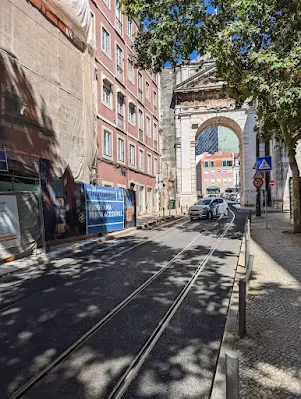
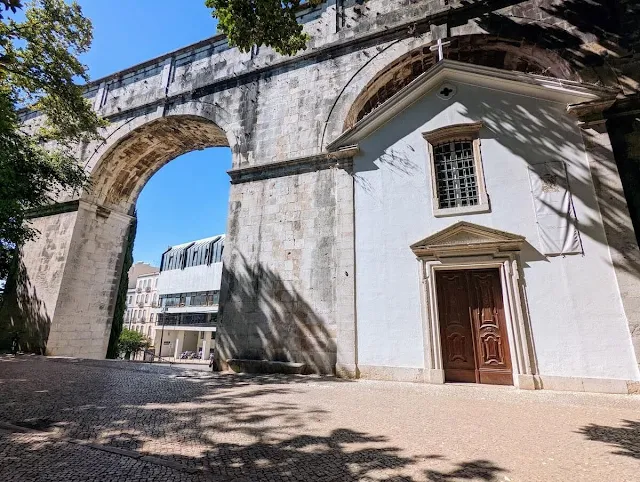



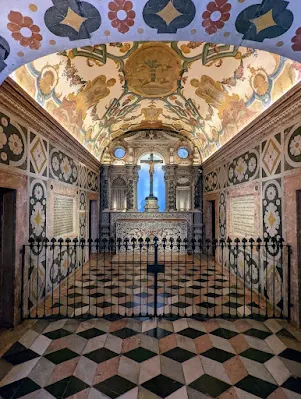




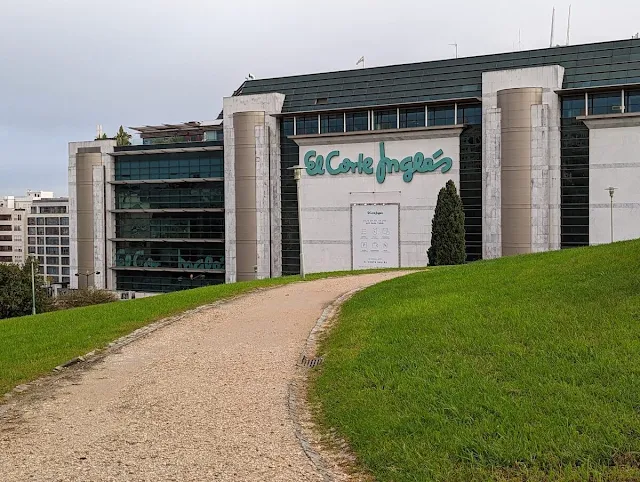
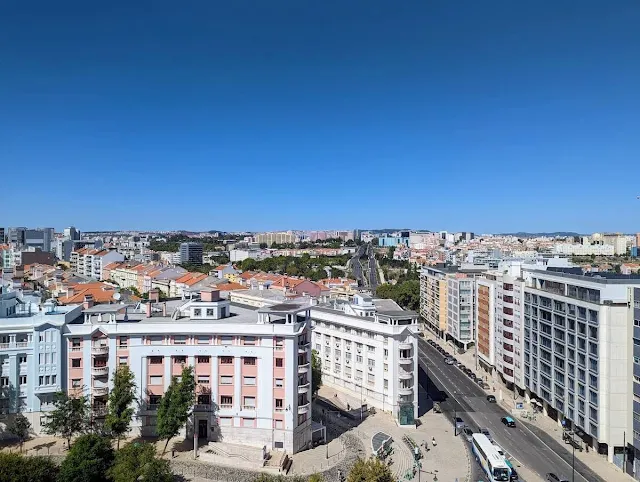
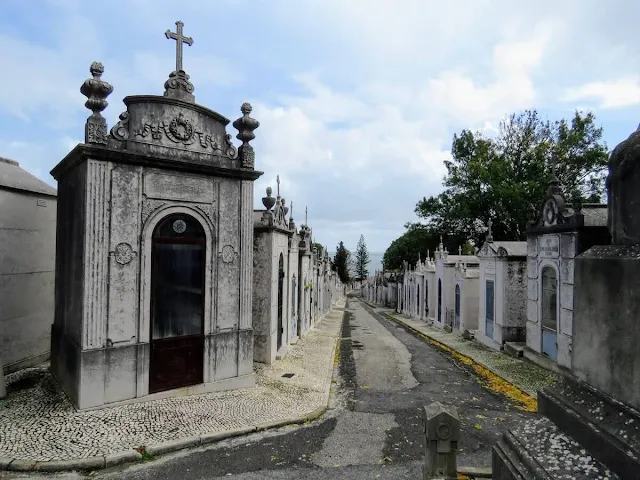




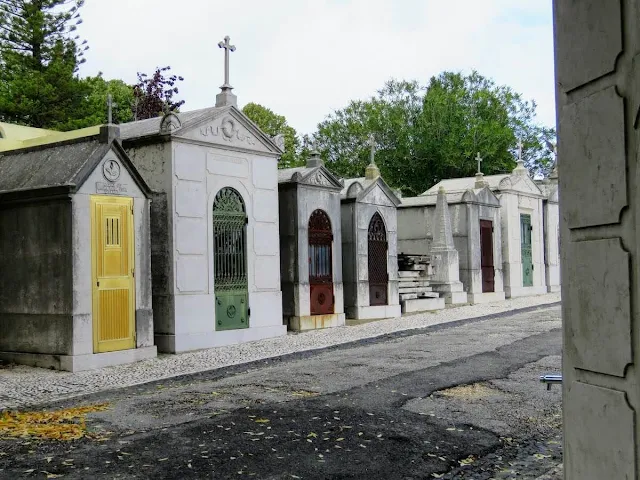

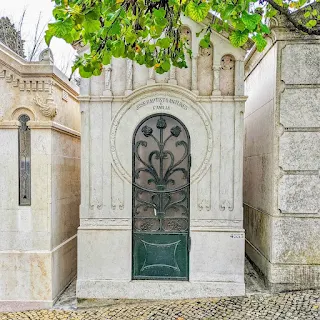












.jpg)
